How To Write A Business Proposal In 12 Simple Steps
 Are you looking to score new clients and grow your business? Then you’ll need to know how to write a business proposal that wins more deals.
Your document will be one of many your prospect receives, so it’s crucial to get it right.
Did you know that business proposals are no longer won over by price alone? The top reason for losing a bid is ‘A competitor/incumbent,’ according to Loopio’s statistics.
You need to be succinct, persuasive, and follow a logical structure.
I have participated in creating hundreds of proposals throughout my marketing career. In this article, I will share my steps for writing a business proposal with specific conversion optimizations to help you close more deals.
Let’s win you new business!
Are you looking to score new clients and grow your business? Then you’ll need to know how to write a business proposal that wins more deals.
Your document will be one of many your prospect receives, so it’s crucial to get it right.
Did you know that business proposals are no longer won over by price alone? The top reason for losing a bid is ‘A competitor/incumbent,’ according to Loopio’s statistics.
You need to be succinct, persuasive, and follow a logical structure.
I have participated in creating hundreds of proposals throughout my marketing career. In this article, I will share my steps for writing a business proposal with specific conversion optimizations to help you close more deals.
Let’s win you new business!
12 Steps To Write A Business Proposal
In most cases, business proposals are written in response to a prospect outreach (formally or informally solicited). You can write yours from scratch in a Word document, from a template, or through proposal software. If you opt for the software solution, you’ll be able to track metrics (like the number of times the proposal was opened) or set automatic reminders. Make use of CoSchedule's Proposal Generator that makes custom and professional proposals! Source
Whichever method you choose, it’s good to familiarize yourself with the most commonly used sections of a business proposal.
Source
Whichever method you choose, it’s good to familiarize yourself with the most commonly used sections of a business proposal.
A business proposal typically consists of elements like:
-
- Title page
- Table of contents
- Executive summary
- A project section
- Portfolio
- Cost page
Step #1: Research Your Audience
Writing a business proposal will be familiar territory if you regularly write blog posts. What both mediums have in common is the need to understand the audience and tailor the content to them.Ensure you have the following details about your prospect:
-
- Goals and business objectives
- Pain points
- Communication preferences
- Timelines
- Budget
 View the Proposify website here.
The form will then automatically populate the costs accordingly.
Be sure to optimize each proposal for each organization. Reference similar use cases throughout the proposal to make yourself the most suitable choice out of all the requests for proposals.
View the Proposify website here.
The form will then automatically populate the costs accordingly.
Be sure to optimize each proposal for each organization. Reference similar use cases throughout the proposal to make yourself the most suitable choice out of all the requests for proposals.
Step #2: Design A Title Or Cover Page
Your title page or cover page is the first impression of your business proposal. Including a cover page accounts for a 4.6% increase in conversion rate. Not bad for a low-content page! It should include the following elements:- Your business name, logo, and contact information
- The prospect’s company name, logo, and contact information
- Date of submission
- Title and description of the project
- Name of the person to whom you’re submitting the proposal
- Bonus: a testimonial from one of your customers
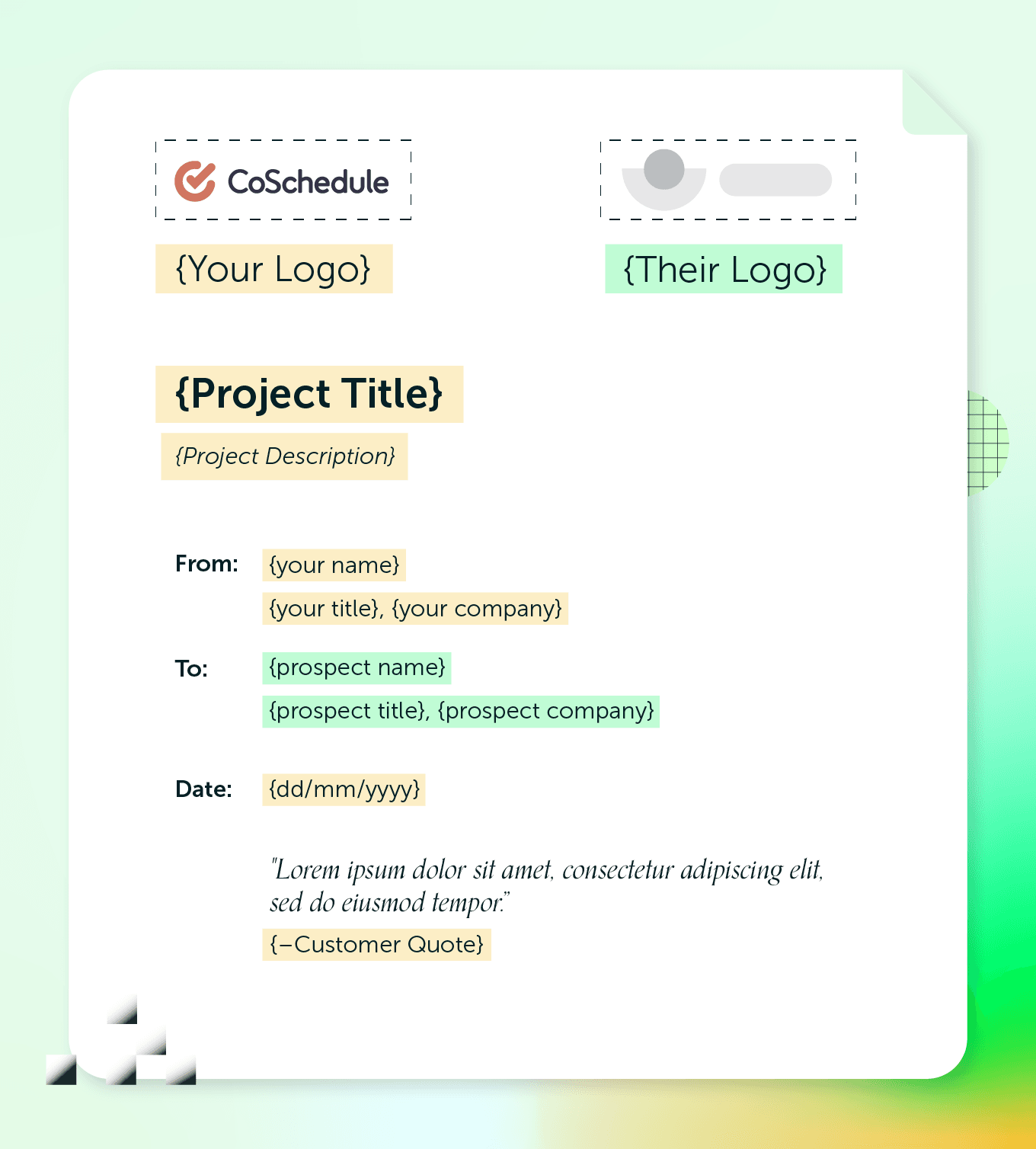 Aim for a professional, clean, yet creative look to make the proposal stand out from all the other submissions.
Aim for a professional, clean, yet creative look to make the proposal stand out from all the other submissions.
Step #3: Generate A Table Of Contents
According to statistics, business proposals generally span 11 pages and are organized into 7 sections. It’s time to leverage a handy table of contents page for easy access! Odds are that multiple people will be involved in the decision-making process at the prospect’s company. Including a table of contents lets your prospect quickly find specific information when needed.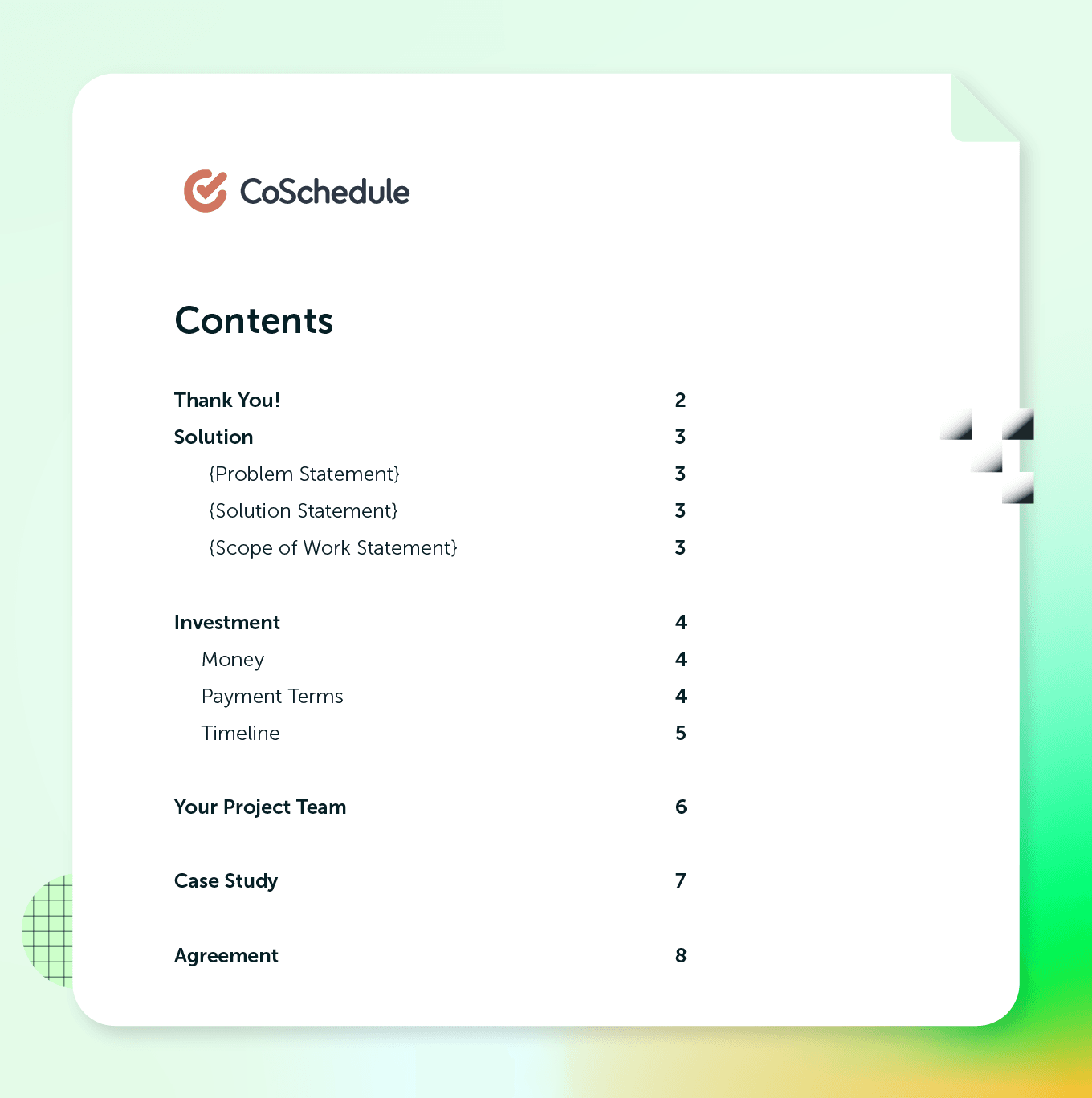 If you’re using Microsoft Word, you can generate this section by selecting the References tab and clicking the “Table of Contents” menu item.
In Google Docs, click Insert, then select “Table of contents.”
How you generate the table of contents section on proposal platforms may vary by software.
If you’re using Microsoft Word, you can generate this section by selecting the References tab and clicking the “Table of Contents” menu item.
In Google Docs, click Insert, then select “Table of contents.”
How you generate the table of contents section on proposal platforms may vary by software.
Step #4: Write An Executive Summary
Your Executive Summary should briefly introduce the reader to your business and how you can help them solve their problem. This page, also sometimes called the Introduction, is the most read page in a proposal, so make sure it includes all of the necessary details that move the conversion needle. The summary should be written in a conversational tone, avoiding jargon and buzzwords as much as possible.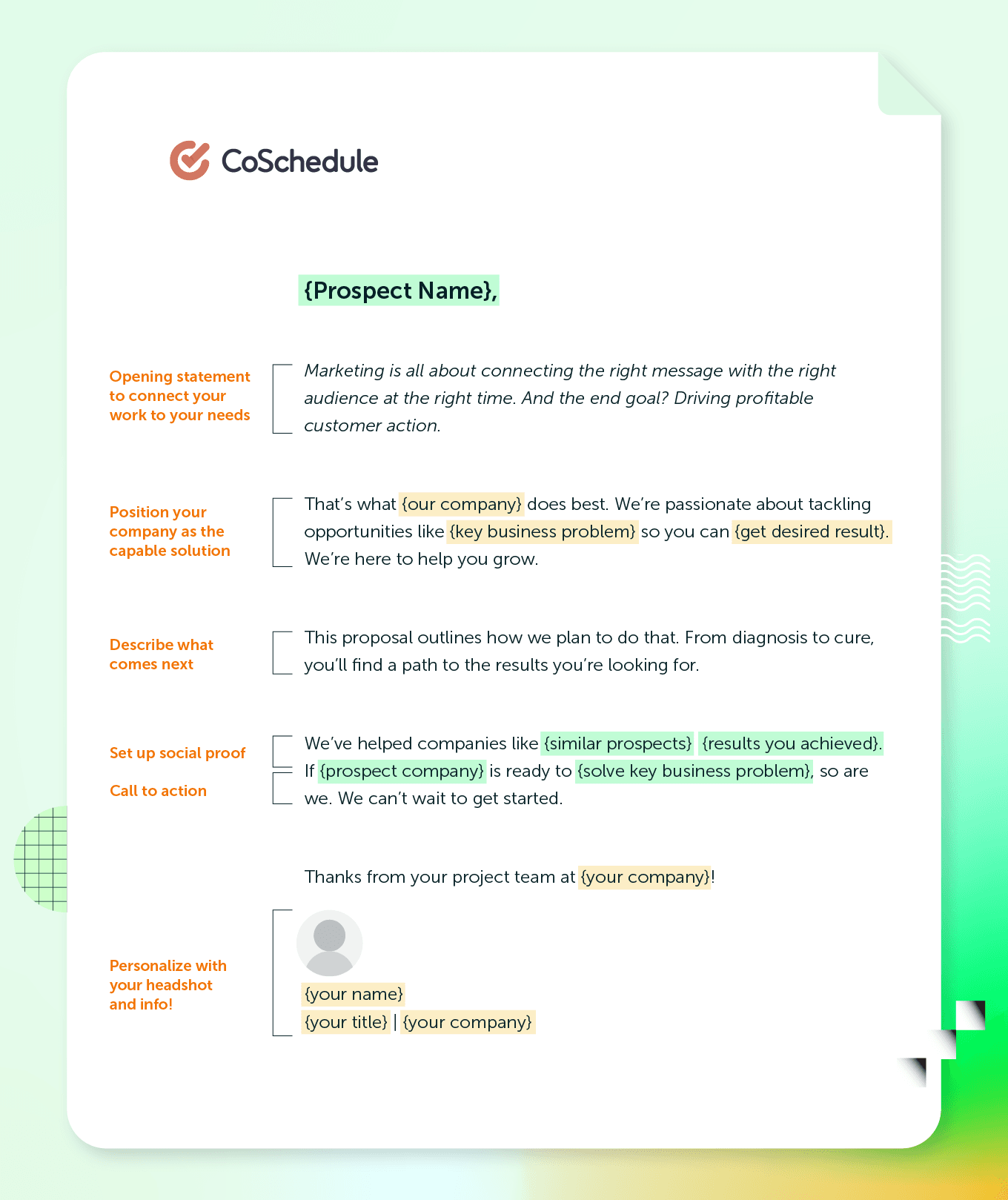 Boost your credibility by listing your company’s qualifications, associations, and achievements in the form of badges or icons.
Keep it at most half a page or about 200-300 words.
Boost your credibility by listing your company’s qualifications, associations, and achievements in the form of badges or icons.
Keep it at most half a page or about 200-300 words.
Step #5: Outline A Problem & Solution
This is where you’ll outline the problem or opportunity your prospect has encountered. Use learnings from your audience research to create a tailored solution that meets their needs. Start with a description of the current situation, then connect it to a solution you offer. Highlight results from your past experiences and successes. You can make it about 400-500 words but balance the page with lots of white space. Use any of the following sales enablement elements in this section:- Past results in the same industry
- Estimated cost and time savings
- Projected outcomes
- Images or a video (using media may result in up to 41-72% higher conversion rates, respectively)
- Supporting data from the industry
- Reviews and testimonials
 Check out this page on proposals.
Business development expert Robyn Haydon says, "Customer testimonials bring your proposal to life. They show you have approached a similar contract or project in the past, and the results you achieved. And because they come from a third party, they also provide independent verification of the value of what you're offering."
If you’re a SaaS business, use services like G2 or TrustRadius to find relevant reviews to feature.
Check out this page on proposals.
Business development expert Robyn Haydon says, "Customer testimonials bring your proposal to life. They show you have approached a similar contract or project in the past, and the results you achieved. And because they come from a third party, they also provide independent verification of the value of what you're offering."
If you’re a SaaS business, use services like G2 or TrustRadius to find relevant reviews to feature.
 Read the full article on this page.
Finally, you can also reference relevant statistics or research from one of your white papers to show authority.
Are you just starting out and don’t have enough content yet? Use a widely known publication to support your case. For example, “According to Forbes’ recent study, businesses should…”
Read the full article on this page.
Finally, you can also reference relevant statistics or research from one of your white papers to show authority.
Are you just starting out and don’t have enough content yet? Use a widely known publication to support your case. For example, “According to Forbes’ recent study, businesses should…”
Step #6: Add A Portfolio Page
Including a portfolio of your past work is vital if you’re in the creative niche, such as graphic design, web design, or even content writing. Highlight only your best work related to your prospect’s project. You can include your portfolio as screenshots or add a link to where you host them. Some great external portfolio sites include Behance, Dribbble, Coroflot, and even Microsoft Sway. Ideally, showcase 3-6 portfolio items in your business proposal.Step #7: Create The Projected Deliverables & Timelines
The deliverables section should outline the timeline of how and when you will complete the project. Break it down by tasks, start dates, end dates, approval details, and total duration. Support your outline with a Gantt chart which will help decision-makers visualize how long the project will take and how much time each task needs.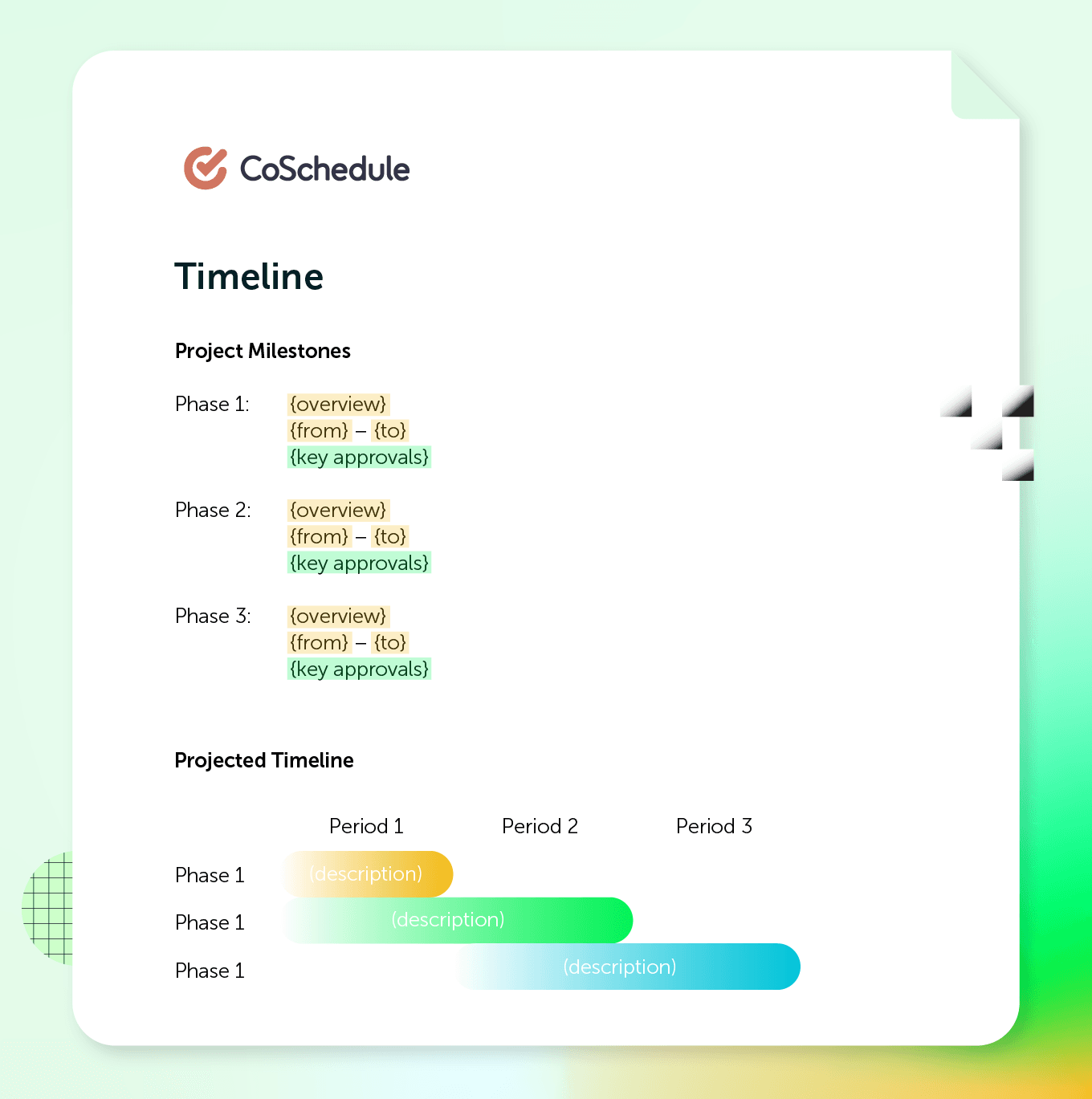 You can also include how often you will be communicating with your client, how long it will take to receive feedback, and how they should request changes.
Make sure the timeline is realistic and consider any holidays or other events that may delay progress.
You can also include how often you will be communicating with your client, how long it will take to receive feedback, and how they should request changes.
Make sure the timeline is realistic and consider any holidays or other events that may delay progress.
Step #8: Provide A Cost Breakdown
No pressure, but this page may be one of the main deciding factors for your prospects choosing you. The cost page is the second most read page in a business proposal. You need to list the project's total cost and how it’s broken down.- Service or product name
- Item price
- Quantity
- Taxes
- Subtotal
- Discounts (Be very careful with this tactic - data shows that discounted proposals see a 23.6% LOWER close rate)
- Total cost
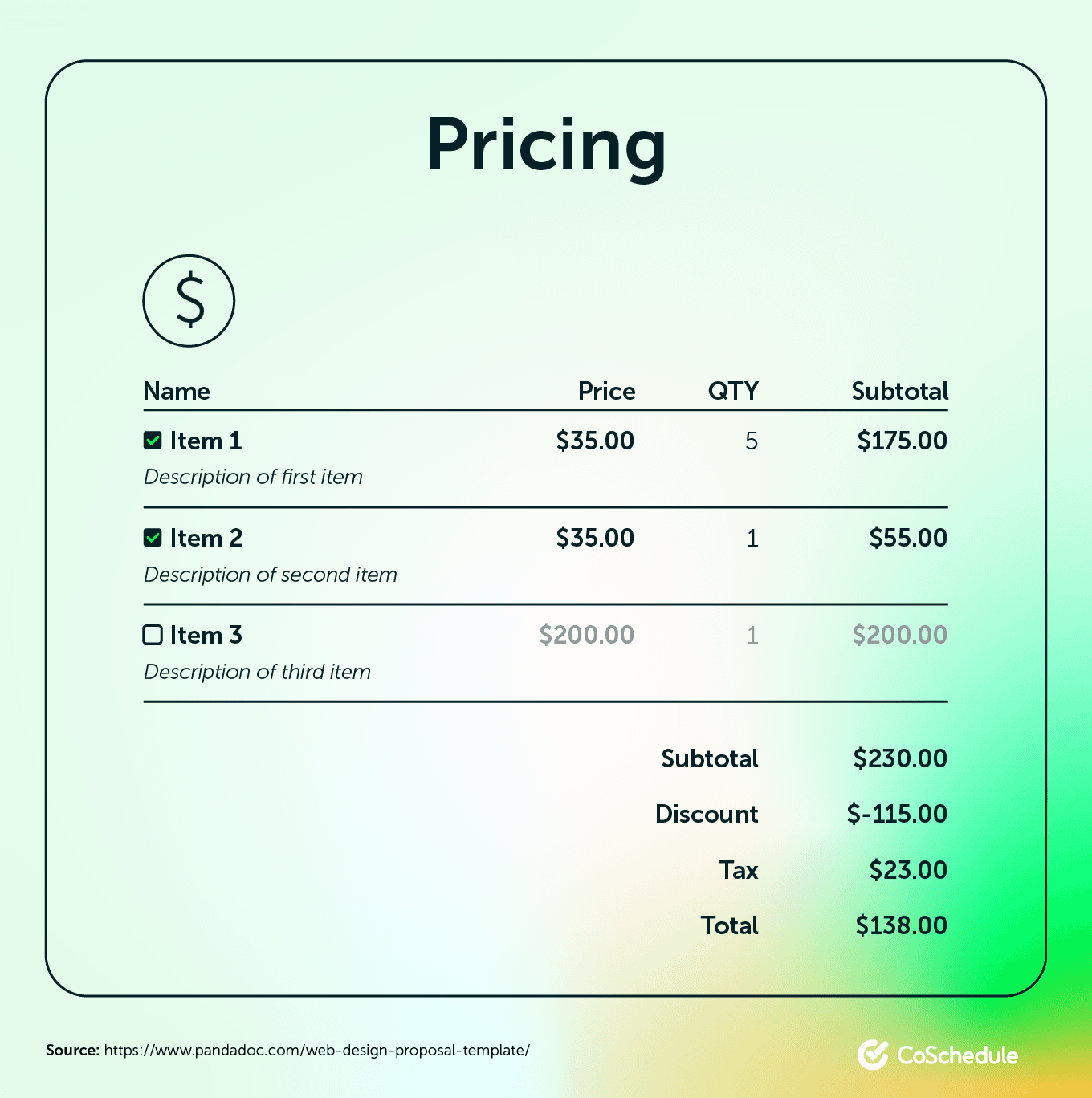 If you are using a proposal platform, take advantage of the interactive pricing tables.
Being able to edit quantities (such as the number of software licenses or design versions) and opt in or out of elective items can improve your close rates by 35.8%.
Include a Next Steps paragraph here, too, with at most 3-4 steps. You can explain to your prospect what to do next and add a payment schedule.
Finally, it may be a small detail, but what you call the cost section can make a difference.
According to Better Proposals, more than half of successfully signed proposals did NOT use the word “Cost” as a title but went with a variation of “Investment,” “ROI,” or similar.
If you are using a proposal platform, take advantage of the interactive pricing tables.
Being able to edit quantities (such as the number of software licenses or design versions) and opt in or out of elective items can improve your close rates by 35.8%.
Include a Next Steps paragraph here, too, with at most 3-4 steps. You can explain to your prospect what to do next and add a payment schedule.
Finally, it may be a small detail, but what you call the cost section can make a difference.
According to Better Proposals, more than half of successfully signed proposals did NOT use the word “Cost” as a title but went with a variation of “Investment,” “ROI,” or similar.
Step #9: Provide Your Terms & Conditions
This part is about protecting yourself, your business, and your clients. Include things like payment schedules, confidentiality agreements, allowed revisions, or warranty information. Add any costs that may arise due to a change in scope. This place is also where to mention how and when you expect to be paid - will it be on delivery? On completion of specific milestones? What happens if they miss a payment or terminate the contract prematurely? When I worked at an agency, we found the best length of the T&C section was about a page or a page and a half at most.Step #10: Add an About Us Page
The About Us page is where you can make a personal connection with the prospect. You can use some of the content from the About Us page of your website, such as the company history or mission statement. It’s a great chance to show how you and your team are the perfect fit for their project, so make sure to include a short bio of everyone involved.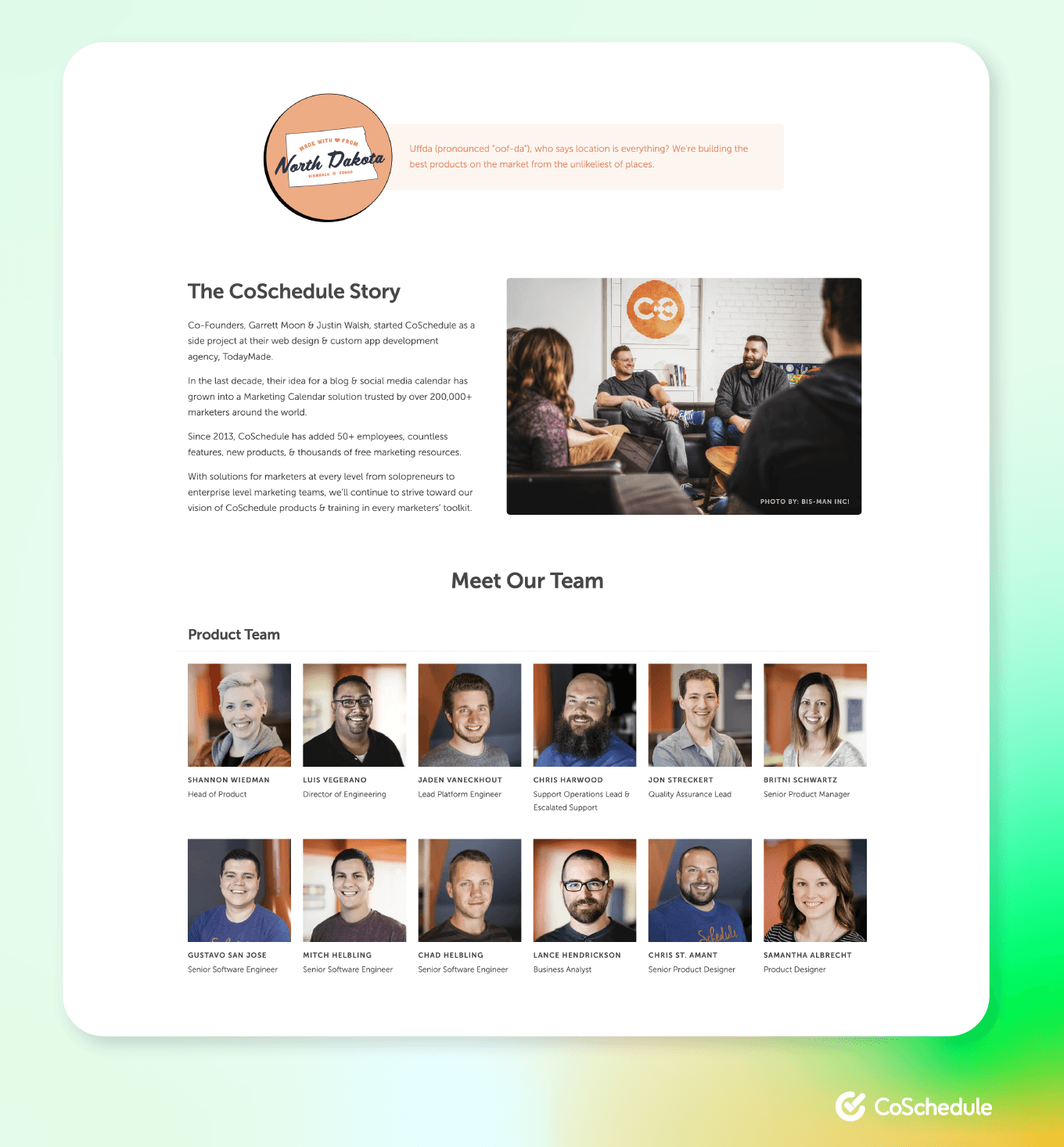 Add awards, certifications, or other relevant achievements for each team member.
Listing their experience and individual strengths can help prospects visualize how your team will approach the project.
Pro-tip: Adding a video to your business proposal can increase close rates by up to 41%.
Simply face the camera, introduce yourself, and explain how you and your team can help the prospect and how excited you are to work with them.
Add awards, certifications, or other relevant achievements for each team member.
Listing their experience and individual strengths can help prospects visualize how your team will approach the project.
Pro-tip: Adding a video to your business proposal can increase close rates by up to 41%.
Simply face the camera, introduce yourself, and explain how you and your team can help the prospect and how excited you are to work with them.
Step #11: Edit Your Business Proposal
On average, business proposals are viewed 7.1 times by prospects. That’s why it’s essential to pay special attention to the editing process and ensure that you hand over a flawless, professional document. Make a checklist for yourself to review:- Typos
- Grammar and spelling errors
- Formatting issues
- Terms, abbreviations, or jargon that may be unclear
- The details around costs
Step #12: Design Your Business Proposal
If you haven’t already, now is the time to design your business proposal. Start by applying a design theme to the proposal. If you’re using Word or PowerPoint, look for the templates or design section. Proposal generator platforms will have their own templates you can customize. In my experience of creating business proposals for a marketing agency, using some of the prospect's design palette often helped us advance to the next step. For example, we often use the prospect's brand color to evoke a familiar look and feel. If the prospect does not have a brand kit and you're uncomfortable digging into a page's source code, use a Chrome extension like the Eyedropper to extract the HEX color codes from the prospect’s website. Pro-tip: Keep them from printing your proposal! If clients print your proposals, you decrease your chances of conversion by 88%. So, omit any print buttons.Use CoSchedule Marketing Suite To Streamline Your Business Proposal Process
CoSchedule Marketing Suite is a family of agile marketing products that helps you coordinate your process, projects, and teams. With Marketing Suite, you can coordinate and execute your business proposal from start to finish.1. Create A Marketing Campaign For Your Business Proposal
Use a Marketing Campaign to document all the individual projects that need to be completed for your business proposal. The Calendar View gives you visibility over all the project deadlines and due dates so you can move tasks and projects around based on capacity.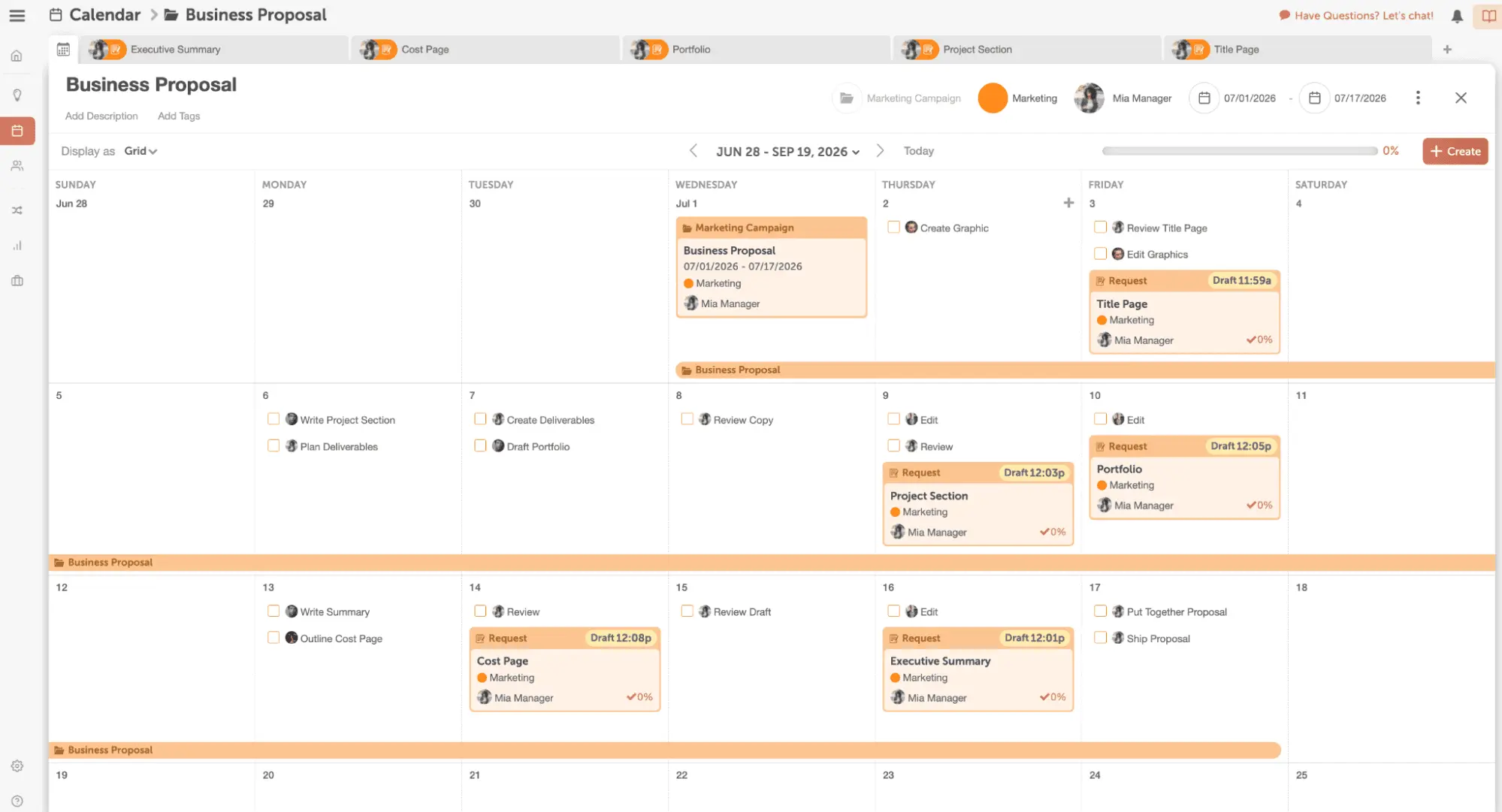
2. Set Up Your Business Proposal Projects
Add all the projects to the campaign that need to be completed for Schedule your business proposal timeline and add project dates to track the completion of the whole project. View all the project deadlines for your proposal in one place.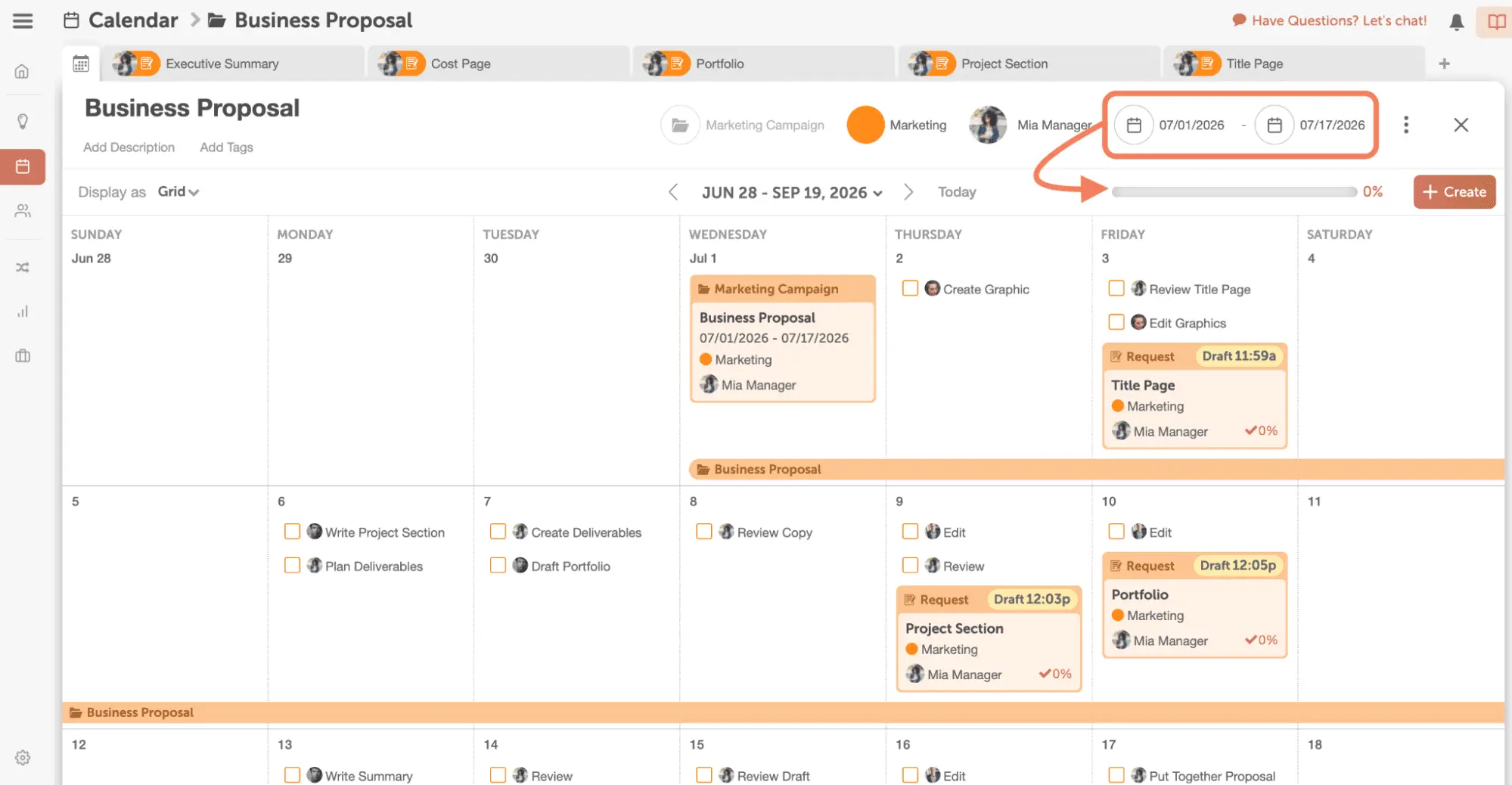
Add Tasks
Under each project, create a list of tasks to ensure every detail is completed for the business proposal.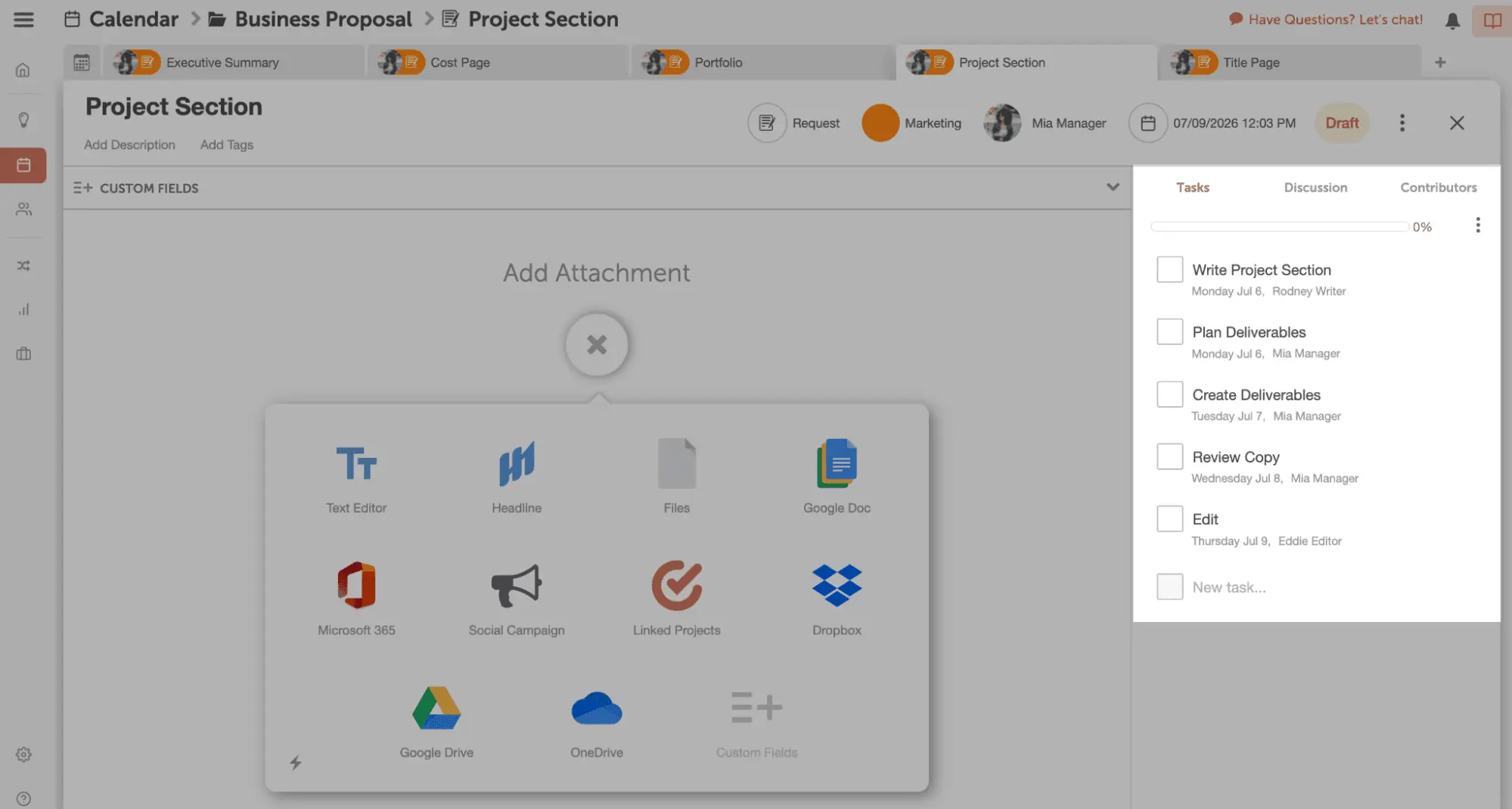 Include tasks in each project to create deliverables, edit sections, and approve the copy.
Include tasks in each project to create deliverables, edit sections, and approve the copy.
Attach Your Proposal
Add a Google Doc or Microsoft Word to your business proposal project. Coordinate all the tasks required to create the proposal and allow all team members access to the proposal to make updates or ship the proposal.
Coordinate all the tasks required to create the proposal and allow all team members access to the proposal to make updates or ship the proposal.
Add Proposal Details To Project
Include additional business proposal details in the text editor attachment to contain clear instructions for creating content for the business proposal. From the design ideas to stakeholders names, write information that is prevalent to the proposal for the team to access.
From the design ideas to stakeholders names, write information that is prevalent to the proposal for the team to access.
3. Delegate Tasks To Your Team
Assign tasks to the designated department to complete every project on time.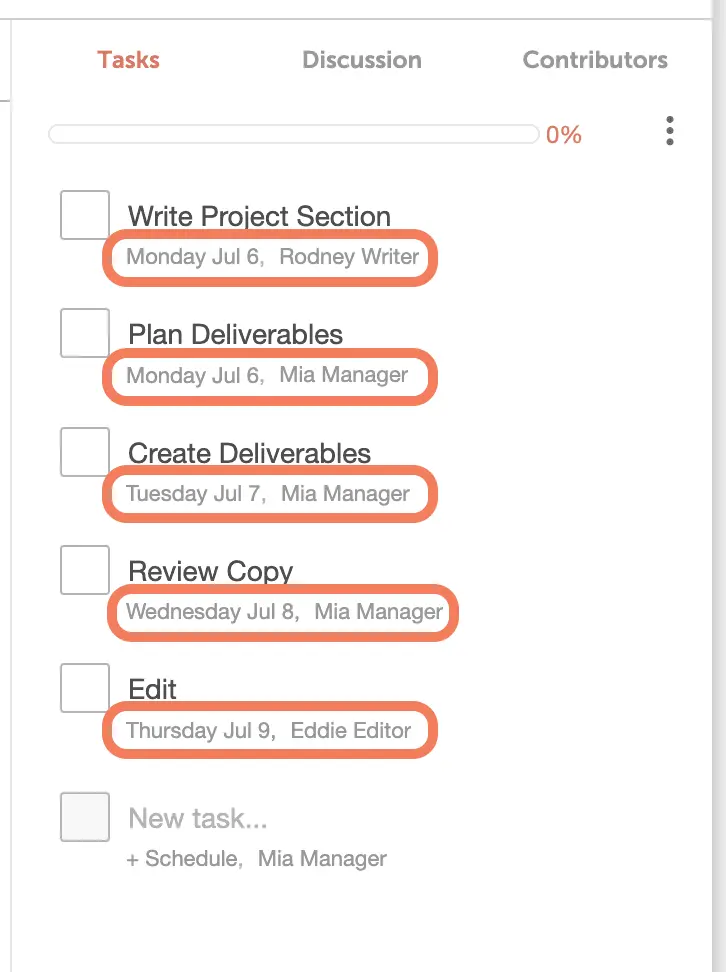 Set the desired completion date with each team member name under each task.
Set the desired completion date with each team member name under each task.
4. Save A Project Template For Your Proposal Process
Want to create more business proposals in the future? Save the entire campaign process as a project template to reuse.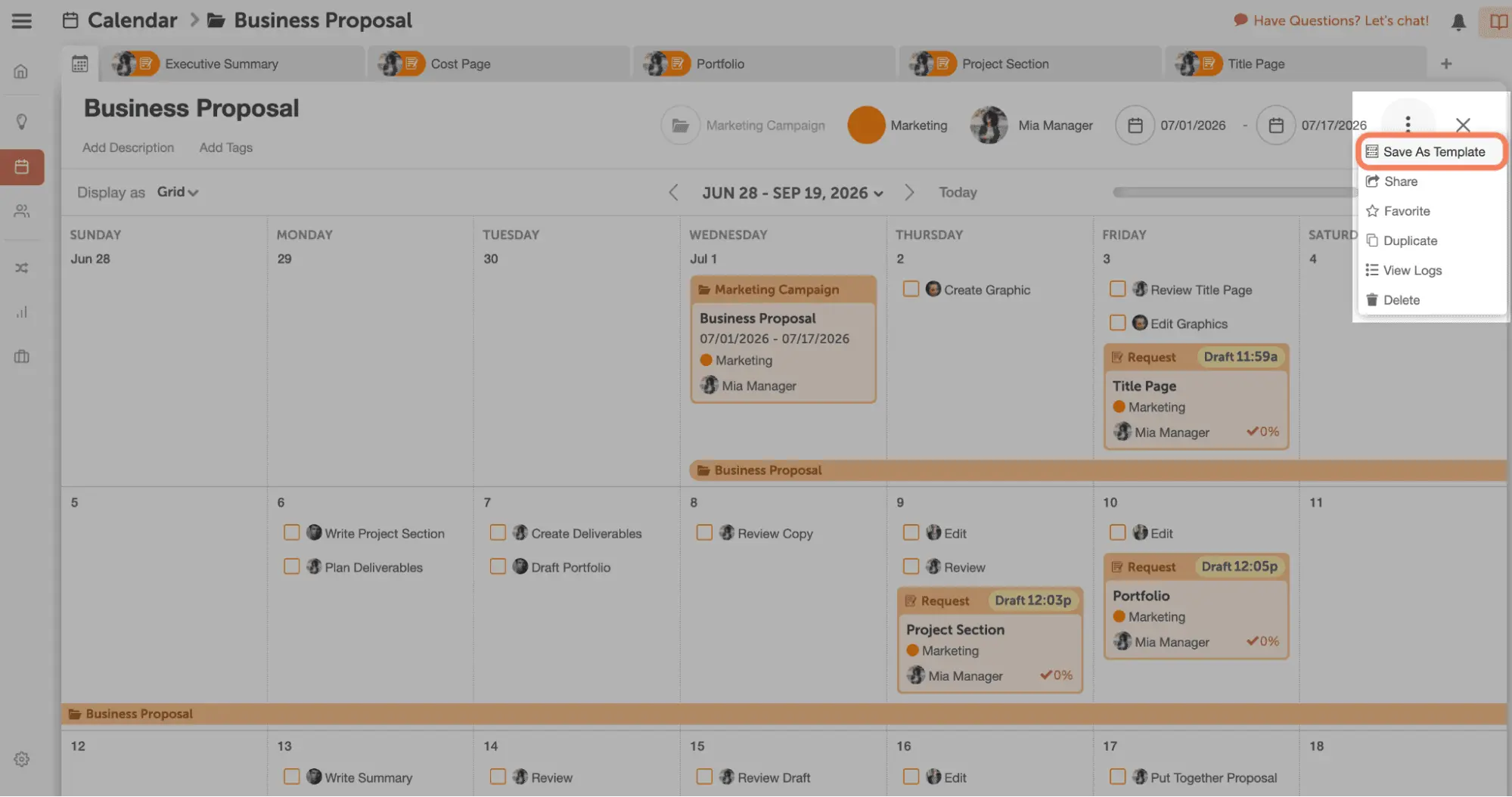 Simplify the process for future business proposals by including project details like project owner, tasks, and attachments to improve efficiency.
Simplify the process for future business proposals by including project details like project owner, tasks, and attachments to improve efficiency.


